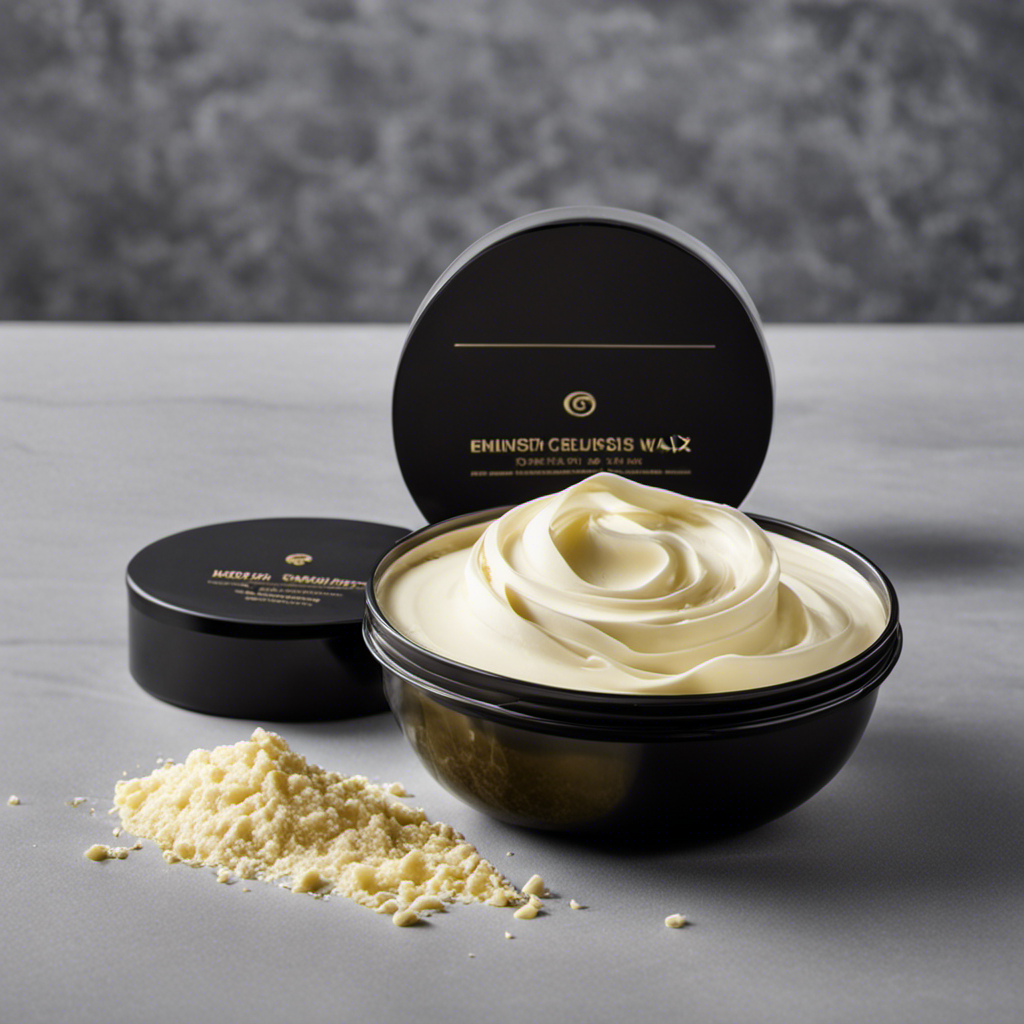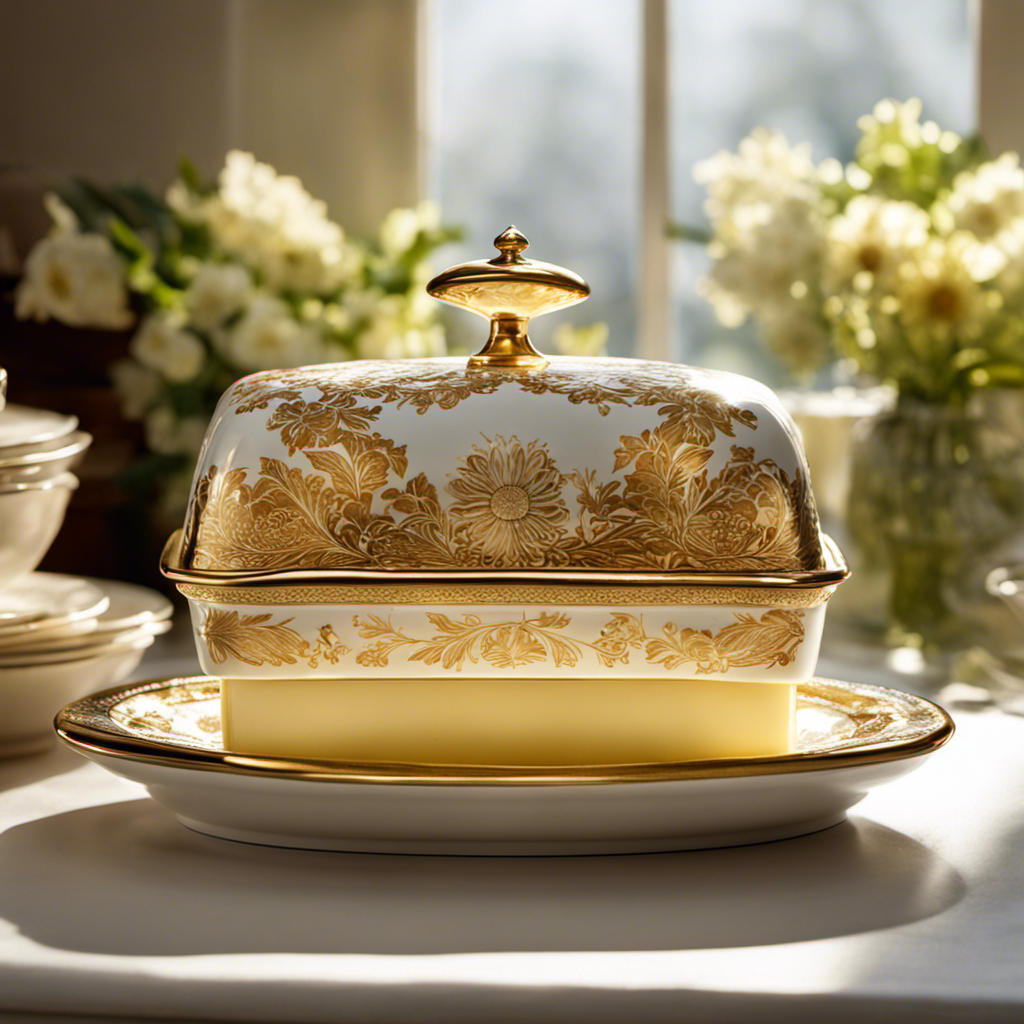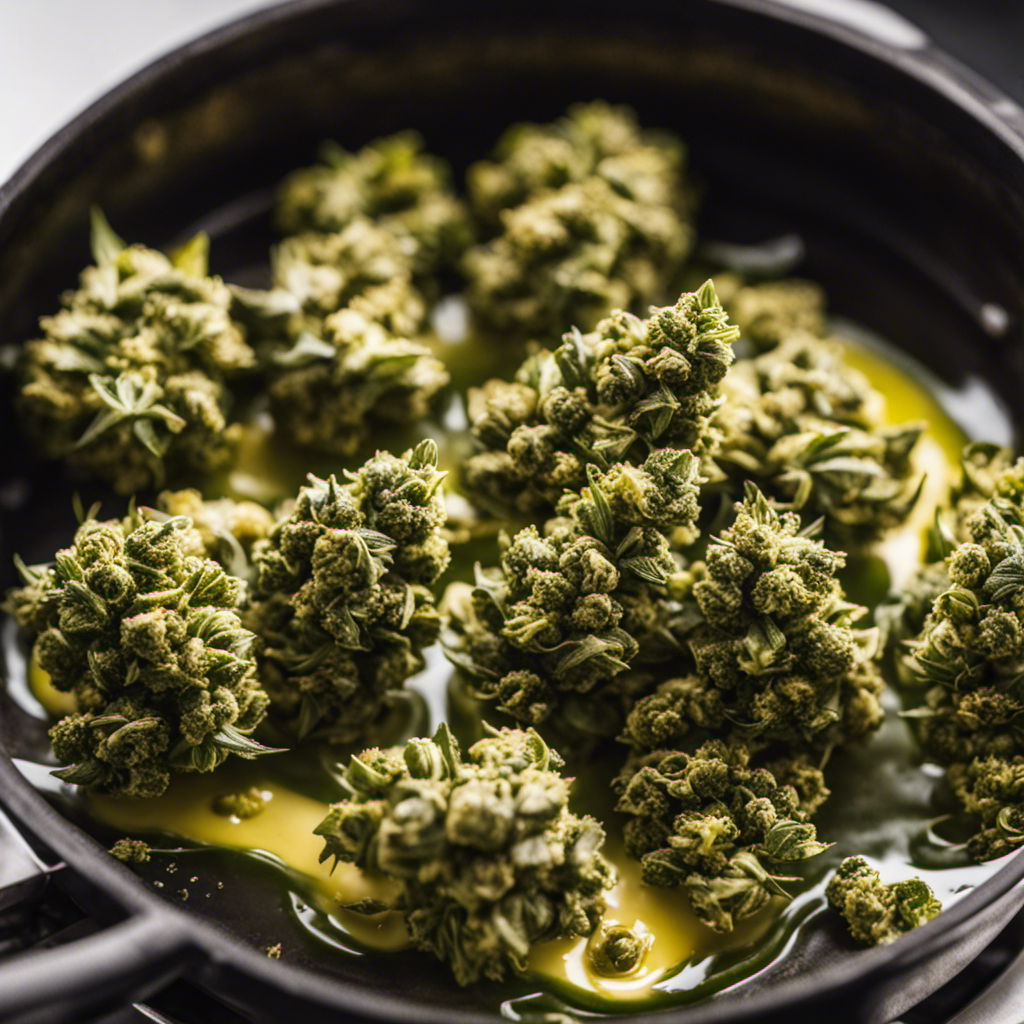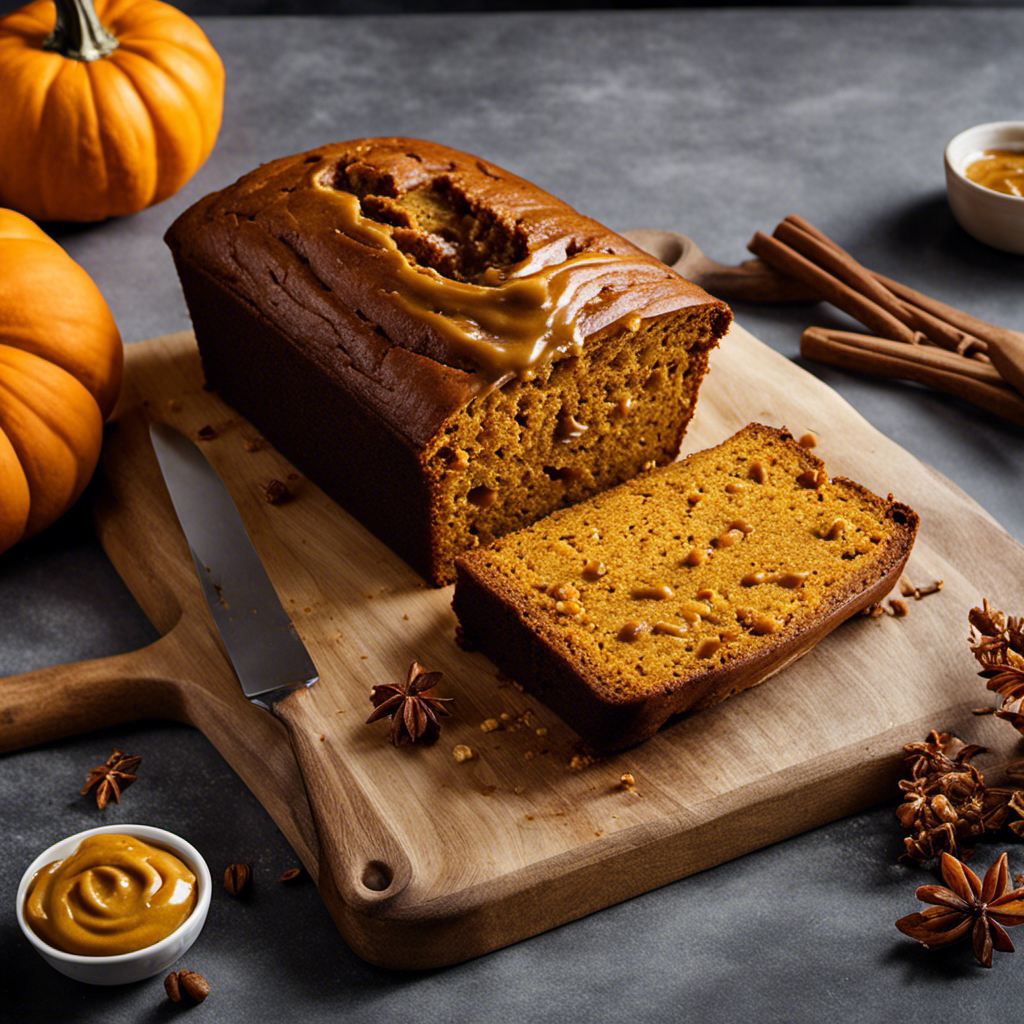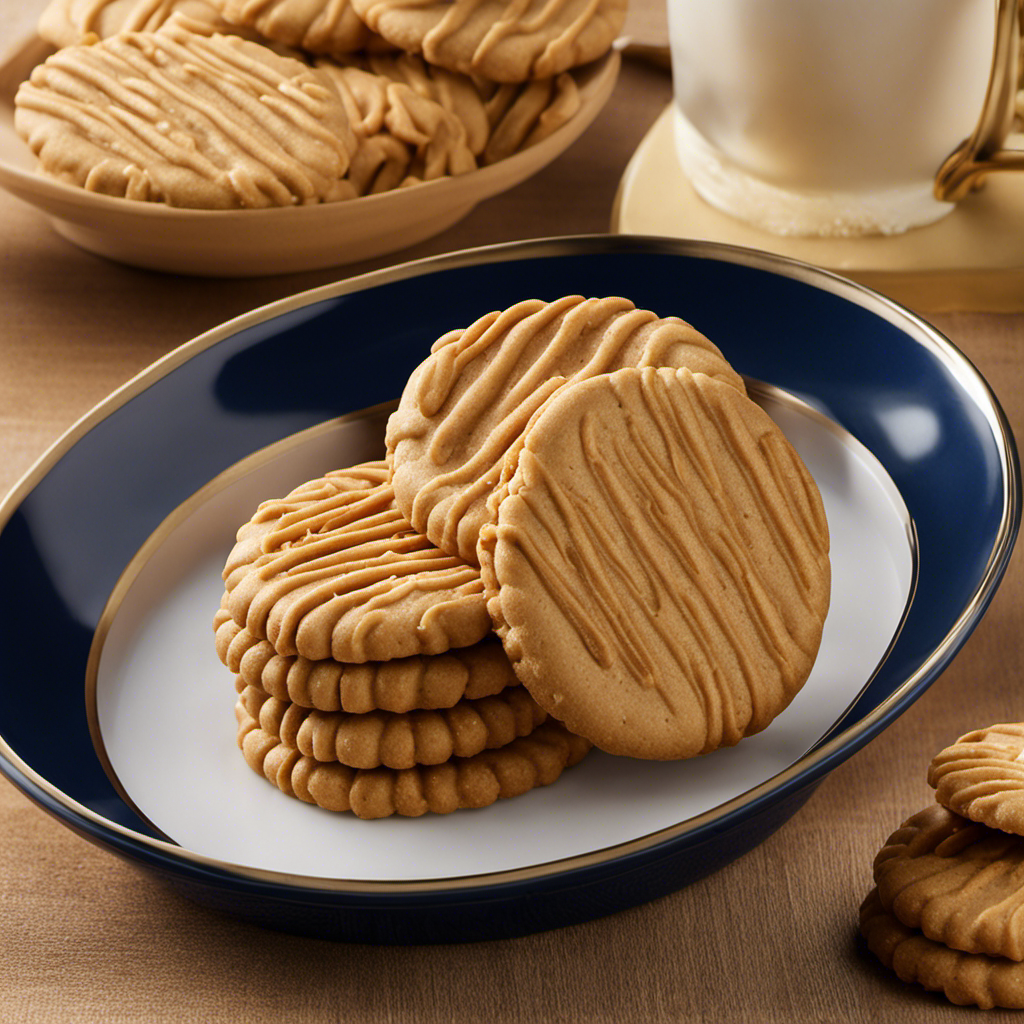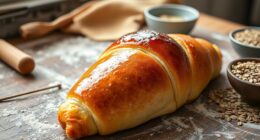When trying to create the perfect body butter, the right amount of emulsifying wax is crucial. After testing different ratios, I understand the importance of precision in this process.
In this article, I will share my expertise on determining the ideal amount of emulsifying wax for your body butter recipe. By following these guidelines, you can achieve a smooth and luxurious consistency that will leave your skin feeling nourished and moisturized.
Let’s dive in and unravel the secrets of emulsifying wax in body butter formulation.
Key Takeaways
- Emulsifying wax binds water and oil together in body butter.
- Factors to consider when determining emulsifying wax amount include oil phase ratio, desired texture, climate conditions, and the type of emulsifying wax chosen.
- Recommended emulsifying wax ratio for body butter is essential for stability, texture, moisturization, and shelf life.
- Adjusting emulsifying wax amount helps achieve different consistencies in body butter.
Understanding Emulsifying Wax
Emulsifying wax is a key ingredient in body butter that helps to bind water and oil together. It has unique properties that make it ideal for creating stable emulsions. Emulsifying wax acts as a surfactant, reducing the surface tension between water and oil molecules, allowing them to mix evenly. This ensures that the body butter has a smooth and creamy texture.
Emulsifying wax is also stable under a wide range of temperatures, making it suitable for various climate conditions. It is essential to choose the right emulsifying wax for your body butter formulation. Some common substitutes for emulsifying wax include beeswax, cetyl alcohol, and stearic acid. However, it is important to note that these substitutes may not provide the same level of stability and emulsification as emulsifying wax, so it is best to use the recommended amount for optimal results.
Factors to Consider When Determining Emulsifying Wax Amount
When determining the amount to use, you should consider various factors for your body butter recipe. Achieving a smooth consistency is essential for a successful body butter formulation. The amount of emulsifying wax you use plays a crucial role in this process. Here are some factors to consider when determining the right amount of emulsifying wax:
| Factor | Description |
|---|---|
| Oil Phase Ratio | The ratio of oils, butters, and other fats to water or other aqueous ingredients in the formulation. |
| Desired Texture | The consistency you want to achieve for your body butter, whether it’s light and fluffy or thick and rich. |
| Climate | The temperature and humidity of your environment can affect the stability of the emulsion. |
| Emulsifier Type | The type of emulsifying wax you choose can impact the amount needed for a stable emulsion. |
Considering these factors will help you determine the appropriate amount of emulsifying wax to use in your body butter recipe, resulting in a smooth and luxurious product.
Recommended Emulsifying Wax Ratio for Body Butter
To achieve the desired texture for your body butter, you’ll want to consider the recommended ratio of emulsifying wax. Emulsifying wax is a key ingredient that helps bind together the water and oil phases of your body butter, creating a smooth and creamy consistency.
Here are some benefits of using emulsifying wax in your body butter:
- Ensures stability and prevents separation of water and oil.
- Provides a luxurious and velvety texture to the body butter.
- Helps the moisturizing ingredients penetrate the skin effectively.
- Enhances the shelf life of the product by preventing microbial growth.
- Allows for the addition of water-based ingredients such as hydrosols or floral waters.
By understanding the benefits of emulsifying wax, you can make an informed decision about using it in your body butter recipe.
Now, let’s explore how to adjust the amount of emulsifying wax for different consistencies.
Adjusting Emulsifying Wax Amount for Different Consistencies
When it comes to achieving the perfect texture in body butter, the optimal wax-to-butter ratio plays a crucial role. Finding the right balance between the amount of wax and butter can greatly affect the final consistency of the product.
Additionally, varying the textures with wax allows for customization, allowing you to create products with different levels of thickness and spreadability.
Optimal Wax-To-Butter Ratio
You’ll want to find the optimal wax-to-butter ratio for your body butter recipe. This ratio is crucial in achieving a smooth texture and the desired consistency of your body butter.
To help you understand the importance of finding the right ratio, here are five key factors to consider:
-
Emulsifying Wax: This ingredient acts as a stabilizer and helps bind the water and oil phases of your body butter together.
-
Butter: Choose a high-quality butter, such as shea or cocoa butter, to provide richness and nourishment to your skin.
-
Carrier Oil: Use a carrier oil like coconut or almond oil to dilute the butter and create a spreadable texture.
-
Essential Oils: Add a few drops of your favorite essential oils for fragrance and additional skin benefits.
-
Whisk or Mixer: Use a whisk or mixer to combine the ingredients thoroughly and achieve a smooth and creamy consistency.
Varying Textures With Wax
If you want a creamier consistency in your recipe, try experimenting with different ratios of wax and butter. Achieving a smooth texture in body butter is all about finding the right balance between wax and butter.
Emulsifying wax is commonly used in body butter recipes to create a stable emulsion and impart a creamy texture. However, the amount of wax you use can greatly impact the final texture. By increasing the ratio of wax to butter, you can achieve a thicker and more solid texture. On the other hand, reducing the amount of wax will result in a softer and more spreadable consistency.
Additionally, there are alternative wax options, such as beeswax or candelilla wax, that can be used to achieve different textures and properties in your body butter recipe. Experimentation is key to finding the perfect texture for your needs.
Common Mistakes When Using Emulsifying Wax in Body Butter
Avoid making common mistakes when using emulsifying wax in your body butter. To achieve a smooth texture, here are some key points to keep in mind:
-
Use the recommended amount of emulsifying wax as stated in your recipe. Using too little can result in a greasy or separated product, while using too much can make your body butter feel waxy and heavy.
-
Ensure that the emulsifying wax is fully melted and incorporated into your oils and butters. Incomplete melting can lead to clumps or graininess in the final product.
-
Do not overheat the emulsifying wax as it can lose its emulsifying properties. Follow the recommended melting temperature and avoid prolonged exposure to heat.
-
Use emulsifying wax specifically formulated for body butters and lotions. Other types of waxes may not provide the desired emulsification and texture.
-
Test your recipe and adjust the amount of emulsifying wax if needed. Different ingredients and formulations may require slight modifications to achieve the desired smoothness.
Troubleshooting Emulsifying Wax Issues in Body Butter
When troubleshooting issues with emulsifying wax in your body butter, it’s important to test your recipe and make any necessary adjustments for a smoother texture. One common problem is emulsifying wax separation, where the wax separates from the other ingredients, leaving a greasy or watery texture. To prevent this, you need to ensure that you are using the correct amount of emulsifying wax in your recipe. Too little wax can lead to separation, while too much can result in a grainy texture. The table below shows the recommended ratios of emulsifying wax to oil in body butter recipes:
| Emulsifying Wax (%) | Oil (%) |
|---|---|
| 6 | 94 |
| 8 | 92 |
| 10 | 90 |
| 12 | 88 |
| 14 | 86 |
Tips and Tricks for Perfectly Emulsified Body Butter
To achieve a perfectly emulsified texture, make sure you are using the recommended ratios of ingredients in your recipe. This will ensure that your body butter is smooth, creamy, and well blended.
Here are some tips and tricks to help you achieve that perfect emulsion:
- Use emulsifying wax alternatives like beeswax or candelilla wax for a natural option.
- Incorporate fragrances in body butter by adding essential oils or fragrance oils during the melting process.
- Heat your oils and water phase separately and make sure they are both around the same temperature before combining.
- Slowly add the water phase to the oil phase while continuously stirring to form an emulsion.
- Use a stick blender or hand mixer to further blend and emulsify the mixture until it reaches a smooth and creamy consistency.
Frequently Asked Questions
Can I Use Emulsifying Wax in Other Skincare Products Besides Body Butter?
Yes, you can use emulsifying wax in other skincare products besides body butter. It is commonly used in facial creams to create a stable emulsion. Exploring different uses for emulsifying wax in skincare products is beneficial.
How Does the Type of Emulsifying Wax Used Affect the Consistency and Texture of Body Butter?
The type of emulsifying wax used greatly impacts the texture and consistency of body butter. Different types can create varying degrees of thickness and smoothness, allowing for a customized experience.
What Are Some Natural Alternatives to Emulsifying Wax That Can Be Used in Body Butter Recipes?
When it comes to body butter, finding natural alternatives to emulsifying wax can be beneficial. These alternatives offer similar emulsification properties while avoiding potentially harmful chemicals found in traditional emulsifying waxes.
Can I Use a Combination of Different Emulsifying Waxes in My Body Butter Recipe?
Combining different emulsifying waxes in body butter recipes can be done to achieve desired texture. Each type of emulsifying wax has its own effect on the final product, so experimentation is key.
Are There Any Potential Side Effects or Skin Reactions Associated With Using Emulsifying Wax in Body Butter?
Using emulsifying wax in body butter may cause potential side effects like skin irritation or allergic reactions. To prevent such reactions, it’s important to follow recommended usage guidelines and perform a patch test before applying to larger areas of skin.
Conclusion
So there you have it, folks! Who would have thought that something as seemingly insignificant as emulsifying wax could make such a difference in the world of body butter? But alas, it does.
By carefully considering the factors at play and using the recommended ratios, you can achieve the perfect consistency for your body butter.
And if you ever run into any issues, don’t fret! With a little troubleshooting and some handy tips and tricks, you’ll be well on your way to creating the most perfectly emulsified body butter you’ve ever laid your hands on.
Happy butter-making!
